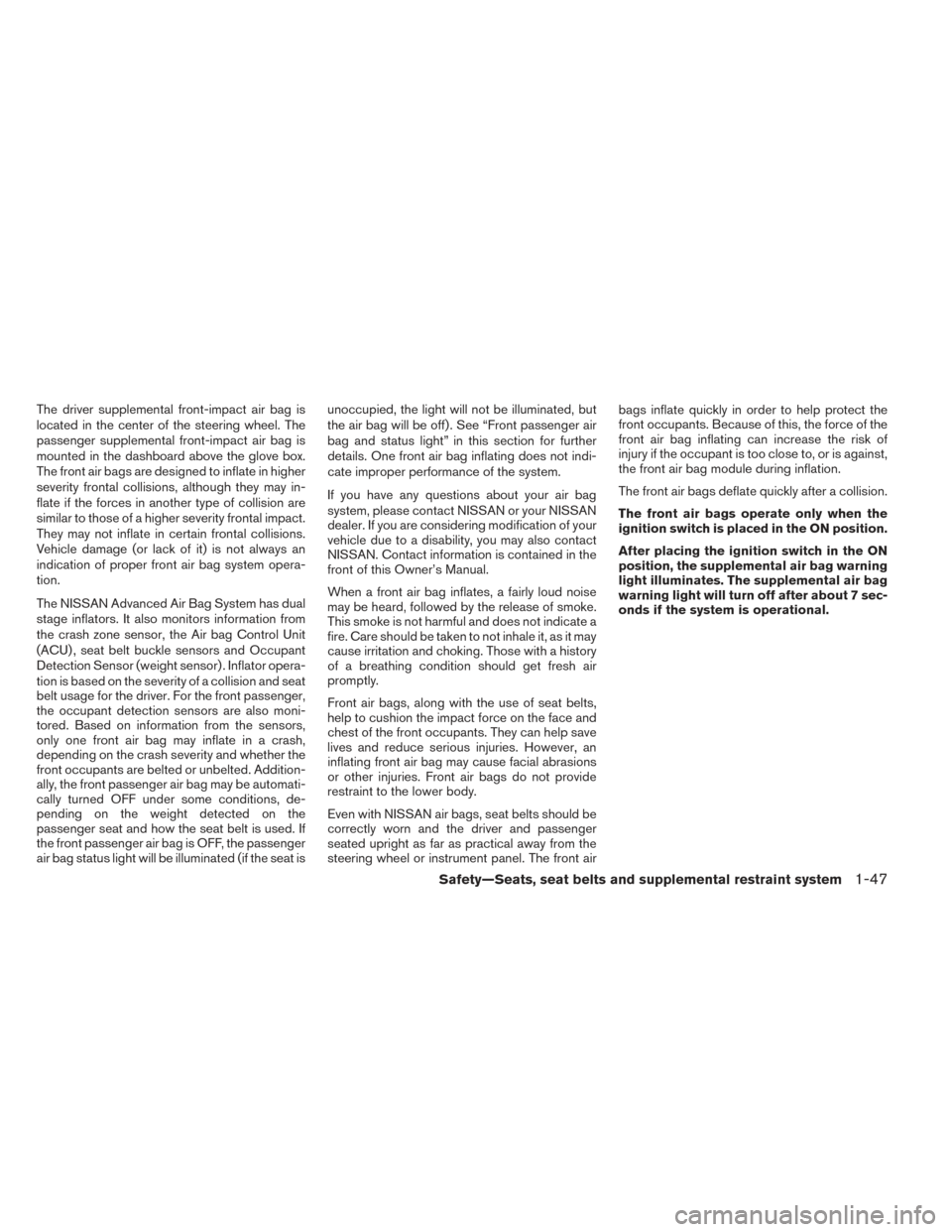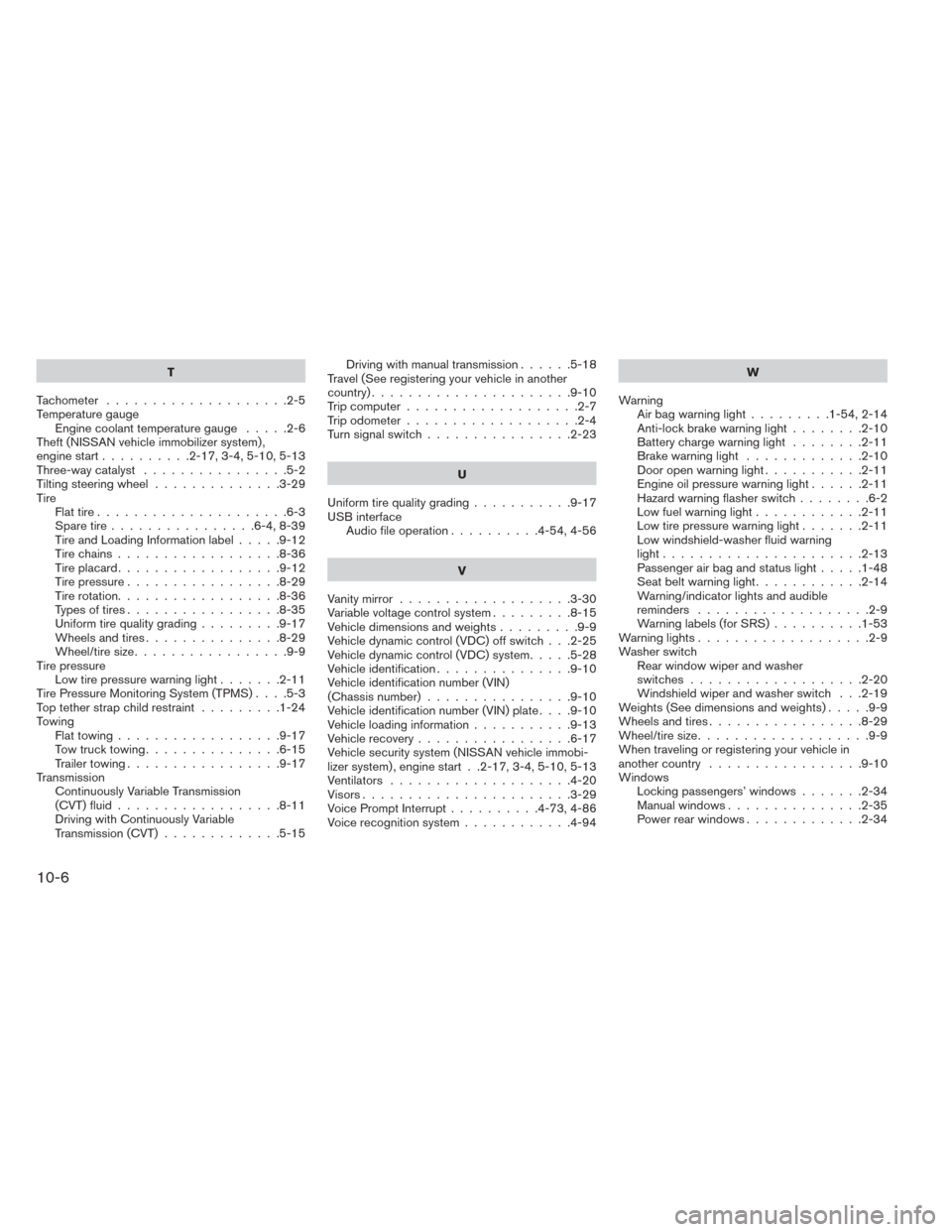2014 NISSAN VERSA NOTE airbag off
[x] Cancel search: airbag offPage 64 of 372

The driver supplemental front-impact air bag is
located in the center of the steering wheel. The
passenger supplemental front-impact air bag is
mounted in the dashboard above the glove box.
The front air bags are designed to inflate in higher
severity frontal collisions, although they may in-
flate if the forces in another type of collision are
similar to those of a higher severity frontal impact.
They may not inflate in certain frontal collisions.
Vehicle damage (or lack of it) is not always an
indication of proper front air bag system opera-
tion.
The NISSAN Advanced Air Bag System has dual
stage inflators. It also monitors information from
the crash zone sensor, the Air bag Control Unit
(ACU) , seat belt buckle sensors and Occupant
Detection Sensor (weight sensor) . Inflator opera-
tion is based on the severity of a collision and seat
belt usage for the driver. For the front passenger,
the occupant detection sensors are also moni-
tored. Based on information from the sensors,
only one front air bag may inflate in a crash,
depending on the crash severity and whether the
front occupants are belted or unbelted. Addition-
ally, the front passenger air bag may be automati-
cally turned OFF under some conditions, de-
pending on the weight detected on the
passenger seat and how the seat belt is used. If
the front passenger air bag is OFF, the passenger
air bag status light will be illuminated (if the seat isunoccupied, the light will not be illuminated, but
the air bag will be off) . See “Front passenger air
bag and status light” in this section for further
details. One front air bag inflating does not indi-
cate improper performance of the system.
If you have any questions about your air bag
system, please contact NISSAN or your NISSAN
dealer. If you are considering modification of your
vehicle due to a disability, you may also contact
NISSAN. Contact information is contained in the
front of this Owner’s Manual.
When a front air bag inflates, a fairly loud noise
may be heard, followed by the release of smoke.
This smoke is not harmful and does not indicate a
fire. Care should be taken to not inhale it, as it may
cause irritation and choking. Those with a history
of a breathing condition should get fresh air
promptly.
Front air bags, along with the use of seat belts,
help to cushion the impact force on the face and
chest of the front occupants. They can help save
lives and reduce serious injuries. However, an
inflating front air bag may cause facial abrasions
or other injuries. Front air bags do not provide
restraint to the lower body.
Even with NISSAN air bags, seat belts should be
correctly worn and the driver and passenger
seated upright as far as practical away from the
steering wheel or instrument panel. The front airbags inflate quickly in order to help protect the
front occupants. Because of this, the force of the
front air bag inflating can increase the risk of
injury if the occupant is too close to, or is against,
the front air bag module during inflation.
The front air bags deflate quickly after a collision.
The front air bags operate only when the
ignition switch is placed in the ON position.
After placing the ignition switch in the ON
position, the supplemental air bag warning
light illuminates. The supplemental air bag
warning light will turn off after about 7 sec-
onds if the system is operational.
Safety—Seats, seat belts and supplemental restraint system1-47
Page 369 of 372

T
Tachometer ....................2-5
Temperature gauge Engine coolant temperature gauge .....2-6
Theft (NISSAN vehicle immobilizer system) ,
engine start ..........2-17,3-4,5-10,5-13
Three-way catalyst ................5-2
Tilting steering wheel ..............3-29
Tire Flat tire .....................6-3
Spare tire ................6-4,8-39
Tire and Loading Information label .....9-12
Tire chains ..................8-36
Tireplacard..................9-12
Tirepressure.................8-29
Tire rotation..................8-36
Types of tires .................8-35
Uniform tire quality grading .........9-17
Wheels and tires ...............8-29
Wheel/tire size .................9-9
Tire pressure Low tire pressure warning light .......2-11
Tire Pressure Monitoring System (TPMS) ....5-3
Top tether strap child restraint .........1-24
Towing Flattowing..................9-17
Towtrucktowing...............6-15
Trailertowing.................9-17
Transmission Continuously Variable Transmission
(CVT) fluid ..................8-11
Driving with Continuously Variable
Transmission (CVT) .............5-15 Driving with manual transmission
......5-18
Travel (See registering your vehicle in another
country) ......................9-10
Trip computer ...................2-7
Trip odometer ...................2-4
Turn signal switch ................2-23
U
Uniform tire quality grading ...........9-17
USB interface Audio file operation ..........4-54,4-56
V
Vanity mirror ...................3-30
Variable voltage control system .........8-15
Vehicle dimensions and weights .........9-9
Vehicle dynamic control (VDC) off switch . . .2-25
Vehicle dynamic control (VDC) system .....5-28
Vehicle identification ...............9-10
Vehicle identification number (VIN)
(Chassis number) ................9-10
Vehicle identification number (VIN) plate ....9-10
Vehicle loading information ...........9-13
Vehicle recovery .................6-17
Vehicle security system (NISSAN vehicle immobi-
lizer system) , engine start . .2-17, 3-4, 5-10, 5-13
Ventilators ....................4-20
Visors.......................3-29
Voice Prompt Interrupt ..........4-73,4-86
Voice recognition system ............4-94 W
Warning Airbagwarninglight.........1-54, 2-14
Anti-lock brake warning light ........2-10
Battery charge warning light ........2-11
Brake warning light .............2-10
Door open warning light ...........2-11
Engine oil pressure warning light ......2-11
Hazard warning flasher switch ........6-2
Low
fuel warning light ............2-11
Low tire pressure warning light .......2-11
Low windshield-washer fluid warning
light......................2-13
Passenger air bag and status light .....1-48
Seatbeltwarninglight............2-14
Warning/indicator lights and audible
reminders ...................2-9
Warning labels (for SRS) ..........1-53
Warninglights...................2-9
Washer switch Rear window wiper and washer
switches...................2-20
Windshield wiper and washer switch . . .2-19
Weights (See dimensions and weights) .....9-9
Wheels and tires .................8-29
Wheel/tire size ...................9-9
When traveling or registering your vehicle in
anothercountry .................9-10
Windows Locking passengers’ windows .......2-34
Manual windows ...............2-35
Power rear windows .............2-34
10-6